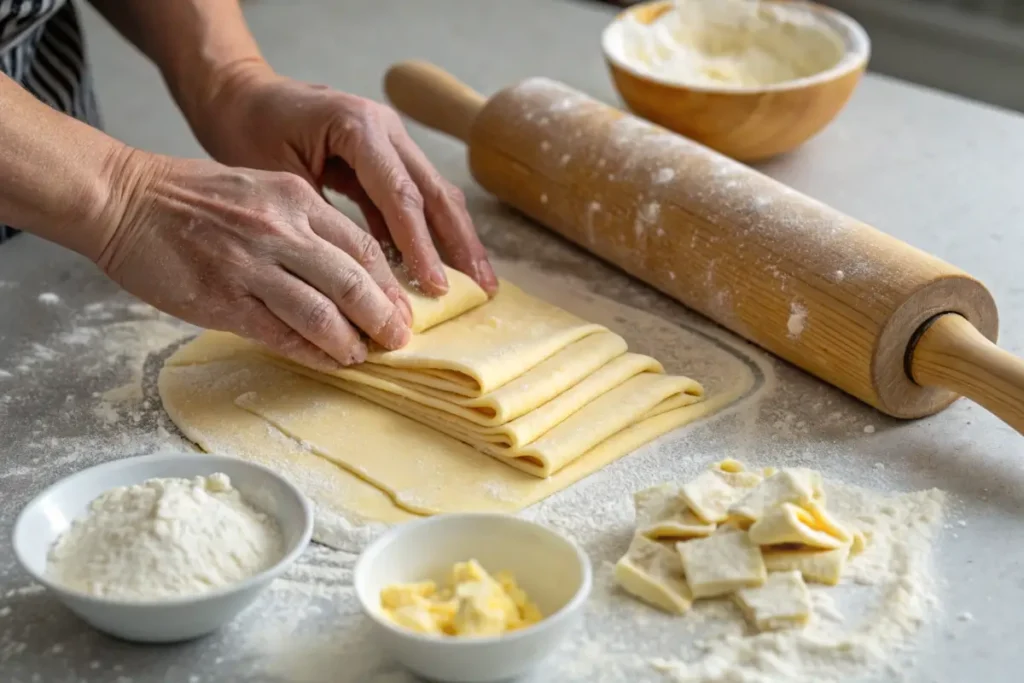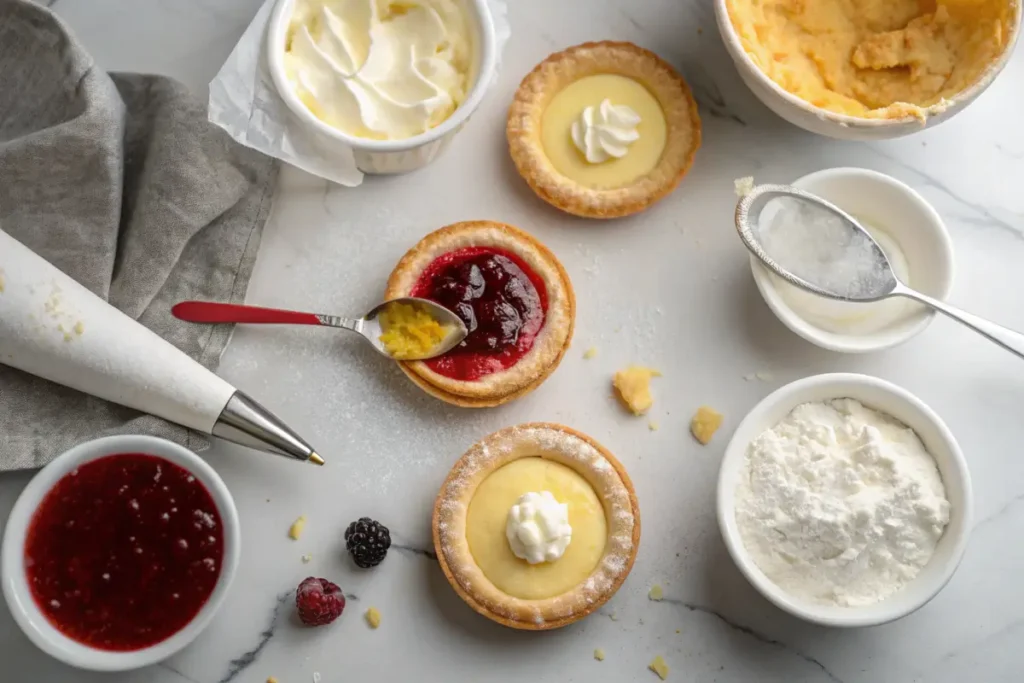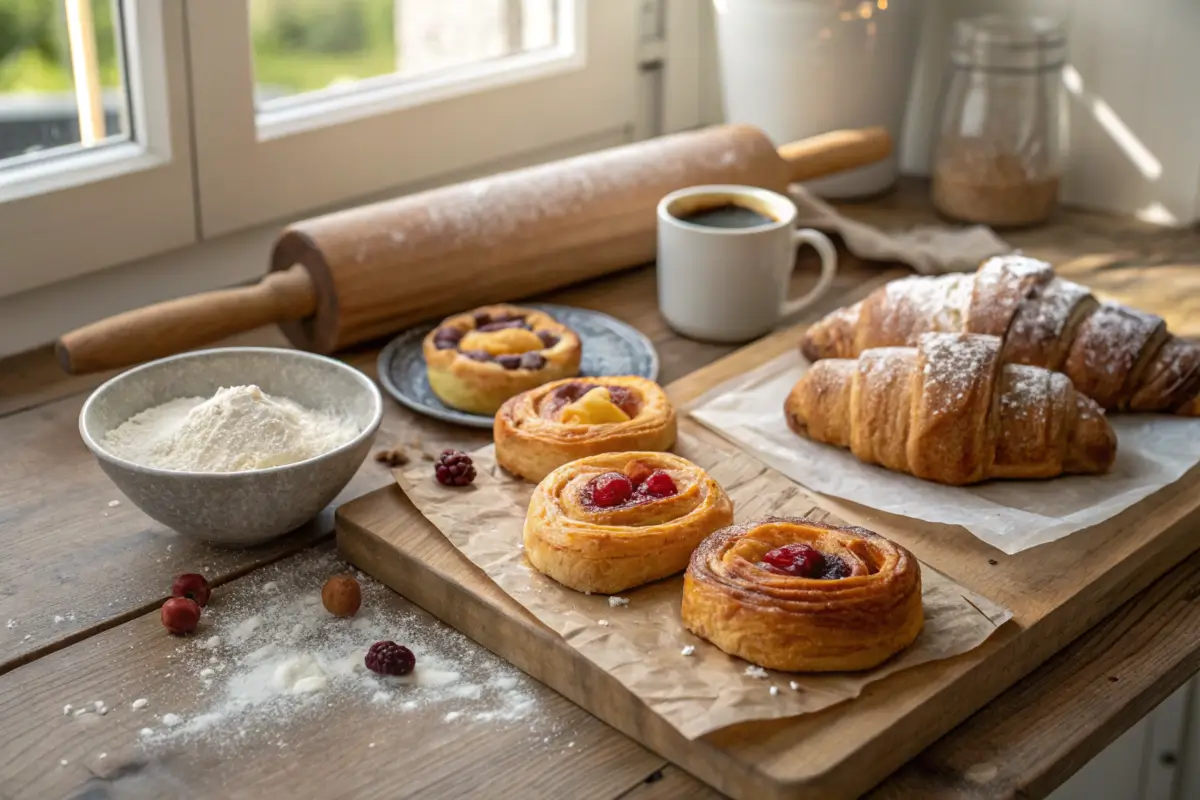Table of Contents
When it comes to morning delights, nothing beats the warm, buttery aroma of fresh homemade breakfast pastries. These delectable treats—ranging from Crispy Danish rolls to stuffed puff pastries—are surprisingly achievable with just a little guidance. Whether you’re a Experienced baker or just starting, this guide will walk you through every step, from crafting the dough to exploring exciting fillings and shaping Steps.
With a mix of classic tips and modern hacks, you’ll discover how to create pastries that rival any bakery’s offerings. Plus, we’ll tackle FAQs and share expert tricks to ensure your pastries are always golden, Crispy, and oh-so-delicious. Let’s dive into Part 1 to understand what makes breakfast pastries so special!
Understanding Breakfast Pastries
What are Breakfast Pastries?
Breakfast pastries are a beloved category of baked goods that are light, Crispy, and often filled with sweet or savory ingredients. They range from classic croissants and Danish pastries to modern takes like savory tarts and fruit-filled pockets. These treats are Maked from versatile doughs like puff pastry, laminated dough, or shortcrust pastry.
Pastries have been a morning staple worldwide, symbolizing indulgence and comfort. Their appeal lies in the perfect balance of buttery layers, tender crumb, and mouthwatering fillings. Whether paired with coffee or enjoyed on their own, they’re a luxurious way to start the day.
Types of Breakfast Pastries Around the World
Breakfast pastries take on unique forms across cultures, reflecting local flavors and traditions:
- Croissants (France): These buttery, crescent-shaped pastries are famous for their flakiness and melt-in-your-mouth texture.
- Danish Pastries (Denmark): A laminated pastry often topped with custard, fruit, or cream cheese.
- Strudels (Central Europe): Thinly stretched dough rolled with fillings like apples, nuts, or poppy seeds.
- Empanadas (Latin America): Savory or sweet pastries with fillings like meat, cheese, or dulce de leche.
- Scones (UK): A crumbly, biscuit-like pastry often served with jam and cream.
Understanding these variations opens a world of inspiration for homemade breakfast ideas. By Mixing Steps and flavors from different cultures, you can Make unique pastries tailored to your taste. Plus, experimenting with recipes encourages creativity in the kitchen.
Essential Ingredients and Tools
Key Ingredients for Breakfast Pastry Dough
When answering the question How do you make homemade breakfast pastries?, the ingredients you choose are the foundation of your success. Here’s what you’ll need:
- Flour: All-purpose flour works for most pastry recipes, but for extra tenderness, consider pastry flour.
- Butter: Always use unsalted, high-fat butter. It’s the key to Making Crispy layers.
- Milk and Cream: These add richness to the dough and a golden finish to baked pastries.
- Yeast: Active dry or instant yeast is essential for puffed, airy pastries like Danish rolls.
- Sugar and Salt: A balanced mix of sweet and savory enhances flavor and structure.
Pro Tip: Use cold ingredients, especially butter, to keep the dough’s structure intact during mixing and rolling.
Special Equipment Needed for Pastry Making
Making homemade breakfast pastries requires a few tools that ensure precision and efficiency:
- Rolling Pin: A sturdy rolling pin is non-negotiable for rolling out dough evenly.
- Pastry Cutter: Perfect for shaping dough into desired forms.
- Baking Mat or Surface: To prevent sticking and maintain consistent thickness.
- Silicone Brush: Ideal for applying egg wash or glazes.
- Sharp Knife or Dough Scraper: Essential for precise cuts and folding.
Having these tools on hand streamlines your baking process and guarantees professional results. Invest in quality equipment, as it can make a significant difference in achieving bakery-quality pastries.
Preparing the Pastry Dough
Classic Danish Pastry Dough Recipe
Mastering Danish pastry dough is a game-changer. This laminated dough creates buttery layers that are crisp on the outside and tender inside. To make it:
- Prepare the Dough Base: Mix flour, sugar, yeast, and salt. Gradually add milk and eggs until combined.
- Incorporate Butter Layers: Roll out the dough, add thin slices of butter, and fold in thirds. Repeat 3–4 times.
- Chill and Rest: Refrigerate between folds to keep the butter solid and layers distinct.

Alternative Dough Options (Puff Pastry, Shortcrust)
Pressed for time? Try these alternatives:
- Store-Bought Puff Pastry: A convenient choice for quick homemade breakfast ideas.
- Shortcrust Pastry: Perfect for tarts and turnovers, offering a crumbly texture.
These options are versatile and allow for creativity in fillings and shapes.
Troubleshooting Common Dough Issues
Even Experienced bakers encounter challenges. Here’s how to solve them:
- Dough Too Sticky: Dust lightly with flour but avoid overworking.
- Butter Melting: Chill dough frequently to maintain separation.
- Uneven Layers: Roll gently and evenly for a smooth structure.
For more pastry insights, check out Breakfast Pastry Recipes, where you’ll find helpful tips to elevate your creations.
Sweet and Savory Fillings
Popular Sweet Fillings (Jam, Custard, Cream Cheese)
When it comes to crafting homemade breakfast pastries, the filling can make all the difference. Sweet options are a classic favorite, and here are a few ideas to get you started:

- Jam or Preserves: Strawberry, raspberry, or apricot jams provide a bright, fruity punch that complements buttery dough.
- Custard: Creamy vanilla custard adds a rich, indulgent touch to Danish pastries.
- Cream Cheese: A slightly tangy cream cheese filling pairs beautifully with fruit toppings or cinnamon.
For a twist, try combining flavors. For instance, mix cream cheese with a dollop of jam for a layered taste experience.
Savory Filling Ideas (Egg, Cheese, Vegetables)
Not all breakfast pastries need to be sweet! Savory options are just as Tasty, especially for those who prefer a heartier start to their day:
- Egg and Cheese: Scrambled eggs with cheddar or Gruyère make for a protein-packed filling.
- Spinach and Feta: A nod to spanakopita, this savory Mix offers a Mediterranean flair.
- Bacon or Sausage: Crumbled cooked meats bring a smoky, satisfying depth.
These savory fillings are ideal for Making portable breakfast options or serving a crowd during brunch.
Tips for Filling Pastries Without Leakage
To prevent fillings from leaking during baking:
- Avoid overstuffing; less is more.
- Seal edges securely using a fork or by pinching.
- Chill the pastries before baking to firm up the dough and filling.
If you’re looking for additional inspiration, check out Cherry Turnovers: The Ultimate Guide to Perfect Crispy Pastries. It’s packed with tips to help you master fruit-filled creations.
Shaping and Baking Steps
Different Shapes for Breakfast Pastries (Braids, Pockets, Twists)
Shaping your homemade breakfast pastries can transform them from simple to stunning. Some popular shapes include:
- Braids: Elegant and perfect for showcasing layered fillings like cream cheese and fruit.
- Pockets: Folded and sealed pastries ideal for savory fillings.
- Twists: Simple yet visually appealing, these are great for cinnamon sugar or pesto spreads.
Experiment with different shapes to suit the occasion or the filling.
Baking Temperature and Time for Optimal Results
To achieve the perfect pastry, precise baking is essential:
- Temperature: Bake most pastries at 375°F to 400°F. This range ensures the dough rises evenly and crisps up beautifully.
- Timing: Keep a close eye during the last 5 minutes of baking. Pastries are done when golden brown.
How to Achieve a Perfect Golden Finish
For a bakery-style sheen:
- Brush pastries with an egg wash (1 egg mixed with 1 tablespoon of water or milk) before baking.
- For sweet pastries, sprinkle with sugar for added sparkle and texture.
Looking to perfect your pastry skills? You’ll find more shaping and baking ideas in Breakfast Pastry Recipes, a helpful resource for all levels of bakers.
Decorating and Serving
Using Icing and Glazes
The final touch on any homemade breakfast pastries is the decoration. A simple icing or glaze can elevate your pastries from delicious to irresistible. Try these options:
- Powdered Sugar Glaze: Mix powdered sugar with a splash of milk or lemon juice for a quick drizzle.
- Vanilla Icing: Combine powdered sugar, vanilla extract, and a bit of milk for a creamy finish.
- Honey or Maple Glaze: Warm honey or maple syrup adds a natural, glossy sheen.
To apply, use a spoon to drizzle the glaze or a piping bag for a more precise look. Always let your pastries cool slightly before adding icing to prevent it from melting too much.
Creative Garnishing Ideas
Don’t stop at icing! Garnishes can add visual appeal and flavor:
- Sprinkle with chopped nuts, shredded coconut, or powdered sugar.
- Add fresh fruit or edible flowers for a vibrant, fresh look.
Serving your pastries warm enhances their buttery aroma and flakiness. Pair them with coffee or tea for a complete breakfast experience.
Storing and Reheating
Proper Storage to Maintain Freshness
Wondering how to keep your homemade breakfast pastries fresh? Here’s how:
- Short-Term Storage: Keep pastries in an airtight container at room temperature for up to 2 days.
- Long-Term Storage: For extended storage, freeze them. Wrap each pastry tightly in plastic wrap and place in a freezer-safe bag.
Proper storage maintains their texture and flavor, so you can enjoy them anytime.
Best Practices for Reheating Pastries
Reheating pastries correctly ensures they taste as good as fresh. Follow these tips:
- Oven: Preheat to 350°F, then bake pastries on a baking sheet for 5–10 minutes.
- Microwave: Use a microwave for quick reheating, but note that it may soften the flakiness. Wrap the pastry in a damp paper towel to retain moisture.
- Toaster Oven: A toaster oven is perfect for reheating smaller pastries, keeping them crisp and warm.
By following these steps, you can recreate that freshly baked magic even days later. Whether you’re indulging solo or hosting a breakfast gathering, these tips keep your pastries Tasty.
Recipe Variations and Tips
Vegan and Gluten-Free Breakfast Pastries
If you’re wondering How do you make homemade breakfast pastries? for dietary needs, don’t worry—there are plenty of options! Here’s how you can adapt recipes for vegan and gluten-free diets:
- Vegan Pastries: Replace butter with plant-based alternatives like coconut oil or vegan margarine. Use flaxseed or applesauce as substitutes for eggs. For fillings, opt for fruit spreads, nut butter, or vegan cream cheese.
- Gluten-Free Pastries: Swap traditional flour for a gluten-free all-purpose Mix. Adding xanthan gum can improve the dough’s elasticity.
While these versions may require slight adjustments, they still deliver flaky and delicious results.
Quick Pastry Options Using Store-Bought Dough
Pressed for time? Using pre-made puff pastry is a fantastic shortcut. Simply roll it out, add your favorite filling, and bake. It’s an easy way to answer How do you make homemade breakfast Desserts? without starting from scratch.
Store-bought options are versatile for both sweet and savory pastries, making them ideal for busy mornings or impromptu brunch gatherings.
Seasonal Pastry Recipes to Try
Let the seasons inspire your creations:
- Spring: Lemon curd or strawberry jam-filled pastries.
- Summer: Fresh peach turnovers or berry tarts.
- Fall: Apple-cinnamon pockets or pumpkin spice twists.
- Winter: Chocolate-filled croissants or cranberry-orange Danish pastries.
By rotating flavors throughout the year, you’ll keep breakfast exciting and seasonal.
Common Questions About Breakfast Pastries
What is the best way to make Crispy pastry at home?
To achieve buttery layers in your Desserts, use chilled ingredients and avoid overworking the dough. Laminating the dough (folding butter into layers) is key to flakiness.
Can I freeze breakfast Desserts?
Yes, you can freeze Desserts before or after baking. For pre-baked pastries, let them cool completely, wrap tightly, and freeze for up to three months. Reheat in the oven to enjoy warm, crisp results.
How do I prevent my pastries from becoming soggy?
Prevent sogginess by chilling your dough and filling beforehand. Also, avoid overfilling, and bake pastries on a lined, ventilated baking sheet for even heat distribution.
Which fillings are best for Starter?
Start simple with jams, Nutella, or cream cheese. These fillings are easy to handle and less likely to leak during baking, ensuring a smooth process for new bakers.
For more pastry tips and tricks, check out related guides on TAS Recipes, like “Breakfast Pastry Recipes” or “Cherry Turnovers.” They’re loaded with inspiration for every skill level.
Conclusion
Making homemade breakfast Tarts is more than just baking—it’s an opportunity to Mix creativity, tradition, and personal flair. Therefore, with the right ingredients, tools, and Steps, you can Make Tarts that rival your favorite bakery’s offerings. From classic Danish dough to sweet and savory fillings, the Opportunities are endless, making every morning a chance to indulge in something new and Tasty.
Whether you’re a Experienced baker or a curious Starter, following these step-by-step tips ensures that your Tarts will turn out golden, Crispy, and absolutely delicious. In addition, with options to suit dietary needs or save time, there’s Really a recipe for everyone. Thus, roll up your sleeves, preheat the oven, and start baking—your perfect breakfast pastry adventure awaits!

